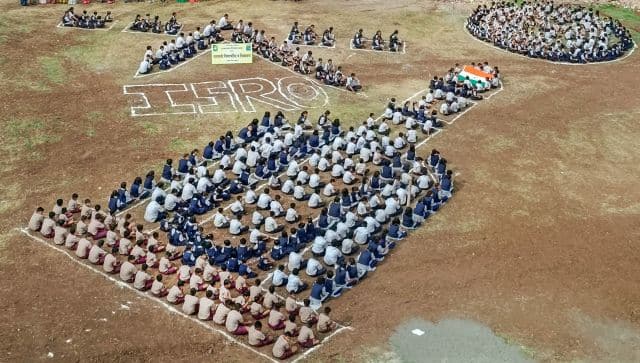The sun has set on the Moon once again. Chandryaan-3’s Vikram lander and Pragyan rover did not wake up during the lunar day, which equals 14 Earth days. Does this mean India’s mission has concluded?
Chandrayaan-3 landed near the Moon’s south pole on 23 August. It was designed to last one lunar day. But when the sunlight began receding on 30 September, there was hope that with a new dawn, the lander and rover, which were put in sleep mode, would wake up and continue their experiments. However, they did not survive the cold frigid cycle of the lunar night.
The European station in Kourou and ISTRAC, Bengaluru had been pinging but there was no response. The sun rose again on the moon on 20 September. The first three days – until 22 September – would have been the best window for the Vikram lander and Pragyan rover to revive.
ISRO chairman S Somnath had told The Times of India (ToI) that the space agency would wait until the last Earth day for the two to wake up. It would be an opportunity to repeat some experiments on the lunar surface. But Vikram and Pragyan failed to respond.
Also read: Chandrayaan-3 costs lesser than big films: How India keeps its space missions frugal
Why did the rover and lander not wake up?
The rover was put into sleep mode on 2 September and the lander on 4 September. Pragyan’s batteries were fully charged and the receiver kept on. The solar panels were oriented so that they would receive sunlight when dawn broke on the moon.
After putting the rover into sleep mode, ISRO said, “The rover completed its assignments. It is now safely parked and set into sleep mode. APXS and LIBS payloads are turned off… Currently, the battery is fully charged. The solar panel is oriented to receive the light at the next sunrise expected on September 22, 2023. The receiver is kept on…”

But moon nights are extremely cold. Temperatures near the moon’s poles drop to anywhere between minus 180 degrees Celsius to minus 253 degrees Celsius. The lander and rover were not designed to survive these extreme conditions. There was absolute darkness on the moon because of which the solar-powered mission received no electricity. There is a possibility that their batteries were affected in the extreme cold.
Manish Purohit, a former ISRO scientist who was involved in the Chandrayaan-2 and Mangalyaan missions, and is a solar panel expert, told ABP Live, “Vikram and Pragyan were expected to wake up after braving the harsh lunar nights where temperatures dip to minus 180 degrees Celsius. The chances of revival were totally dependent on the batteries surviving the long lunar nights.”
Former ISRO chief AS Kiran Kumar told BBC that many of the components may not have survived the extreme conditions on the Moon.
The rover and lander are not equipped with heaters which are commonly used for moon missions, according to a report in Space.com. “These heaters, called radioisotope heater units (RHUs), work by passively radiating heat to keep the hardware onboard spacecraft at sustainable operating temperatures. Most commonly, RHUs used in space missions convert heat generated from the natural decay of radioactive versions of plutonium or polonium into electrical power. This process ultimately warms spacecraft hardware, though mostly just enough to help it survive very cold temperatures,” the report says.
Without the heaters, the survival of Vikram and Pragyan is left to chance.
Is there a chance of revival still?
ISRO has not given up all hope.
M Sankaran, director, UR Rao Satellite Centre, the lead centre for Chandrayaan-3 told ToI, “The lander and rover have not woken up. While chances of them waking up after this lunar night ends in the next 14 days are very very slim, we are not closing the option.”
What happens to Vikram and Pragyan if they never wake up?
ISRO had said earlier that if the duo does not wake up, “it will forever stay there as India’s lunar ambassador.”
Vikram and Pragyan are not designed to return to Earth.

Are the lander and rover space junk?
No says, space and aerospace expert, Girish Linganna. “Vikram and Pragyan cannot be considered space junk after they become defunct. Since both will remain on the Moon’s surface after becoming defunct, they cannot be considered ‘space debris’ as the term refers only to non-functional objects remaining in Earth’s orbit, posing a risk to active spacecraft, as these objects include abandoned spacecraft, fragments from disintegration and even minuscule particles resulting from various space activities,” Linganna was quoted as saying by The Week.
What has Chandrayaan-3 achieved?
Despite many failed attempts to wake up the Vikram-Prayaan duo, Somanath believes that the Moon mission is largely a success as it has already accomplished its stated objectives. “It is OK if it does not wake up because the rover has done what it was expected to do,” the ISRO chief told the media earlier.
The main objective was to soft-land the spacecraft on the moon. With that, India joined the small club of countries to have achieved the feat. They include the United States, China, and the erstwhile Soviet Union. India also became the first nation to land near the south pole of the lunar surface.

During the mission, the rover travelled a distance of around 100 metres and detected the presence of several elements on the Moon including the presence of sulphur, which was a first.
One of the most talked-about experiments was the hop by the Vikram lander. It was not planned by ISRO before the launch. It’s therefore being said that the mission has exceeded expectations.
With inputs from agencies
from Firstpost India Latest News https://ift.tt/boByxPg
No comments:
Post a Comment